Bin Yu
PhysBrain: Human Egocentric Data as a Bridge from Vision Language Models to Physical Intelligence
Dec 18, 2025Abstract:Robotic generalization relies on physical intelligence: the ability to reason about state changes, contact-rich interactions, and long-horizon planning under egocentric perception and action. However, most VLMs are trained primarily on third-person data, creating a fundamental viewpoint mismatch for humanoid robots. Scaling robot egocentric data collection remains impractical due to high cost and limited diversity, whereas large-scale human egocentric videos offer a scalable alternative that naturally capture rich interaction context and causal structure. The key challenge is to convert raw egocentric videos into structured and reliable embodiment training supervision. Accordingly, we propose an Egocentric2Embodiment translation pipeline that transforms first-person videos into multi-level, schema-driven VQA supervision with enforced evidence grounding and temporal consistency, enabling the construction of the Egocentric2Embodiment dataset (E2E-3M) at scale. An egocentric-aware embodied brain, termed PhysBrain, is obtained by training on the E2E-3M dataset. PhysBrain exhibits substantially improved egocentric understanding, particularly for planning on EgoThink. It provides an egocentric-aware initialization that enables more sample-efficient VLA fine-tuning and higher SimplerEnv success rates (53.9\%), demonstrating effective transfer from human egocentric supervision to downstream robot control.
PLoP: Precise LoRA Placement for Efficient Finetuning of Large Models
Jun 25, 2025

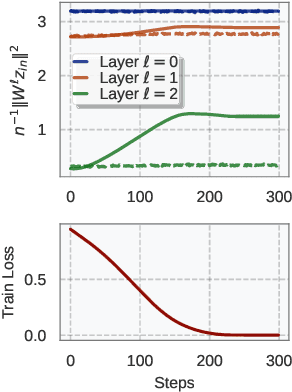

Abstract:Low-Rank Adaptation (LoRA) is a widely used finetuning method for large models. Its small memory footprint allows practitioners to adapt large models to specific tasks at a fraction of the cost of full finetuning. Different modifications have been proposed to enhance its efficiency by, for example, setting the learning rate, the rank, and the initialization. Another improvement axis is adapter placement strategy: when using LoRA, practitioners usually pick module types to adapt with LoRA, such as Query and Key modules. Few works have studied the problem of adapter placement, with nonconclusive results: original LoRA paper suggested placing adapters in attention modules, while other works suggested placing them in the MLP modules. Through an intuitive theoretical analysis, we introduce PLoP (Precise LoRA Placement), a lightweight method that allows automatic identification of module types where LoRA adapters should be placed, given a pretrained model and a finetuning task. We demonstrate that PLoP consistently outperforms, and in the worst case competes, with commonly used placement strategies through comprehensive experiments on supervised finetuning and reinforcement learning for reasoning.
Local MDI+: Local Feature Importances for Tree-Based Models
Jun 10, 2025Abstract:Tree-based ensembles such as random forests remain the go-to for tabular data over deep learning models due to their prediction performance and computational efficiency. These advantages have led to their widespread deployment in high-stakes domains, where interpretability is essential for ensuring trustworthy predictions. This has motivated the development of popular local (i.e. sample-specific) feature importance (LFI) methods such as LIME and TreeSHAP. However, these approaches rely on approximations that ignore the model's internal structure and instead depend on potentially unstable perturbations. These issues are addressed in the global setting by MDI+, a feature importance method which exploits an equivalence between decision trees and linear models on a transformed node basis. However, the global MDI+ scores are not able to explain predictions when faced with heterogeneous individual characteristics. To address this gap, we propose Local MDI+ (LMDI+), a novel extension of the MDI+ framework to the sample specific setting. LMDI+ outperforms existing baselines LIME and TreeSHAP in identifying instance-specific signal features, averaging a 10% improvement in downstream task performance across twelve real-world benchmark datasets. It further demonstrates greater stability by consistently producing similar instance-level feature importance rankings across multiple random forest fits. Finally, LMDI+ enables local interpretability use cases, including the identification of closer counterfactuals and the discovery of homogeneous subgroups.
CDR-Agent: Intelligent Selection and Execution of Clinical Decision Rules Using Large Language Model Agents
May 29, 2025Abstract:Clinical decision-making is inherently complex and fast-paced, particularly in emergency departments (EDs) where critical, rapid and high-stakes decisions are made. Clinical Decision Rules (CDRs) are standardized evidence-based tools that combine signs, symptoms, and clinical variables into decision trees to make consistent and accurate diagnoses. CDR usage is often hindered by the clinician's cognitive load, limiting their ability to quickly recall and apply the appropriate rules. We introduce CDR-Agent, a novel LLM-based system designed to enhance ED decision-making by autonomously identifying and applying the most appropriate CDRs based on unstructured clinical notes. To validate CDR-Agent, we curated two novel ED datasets: synthetic and CDR-Bench, although CDR-Agent is applicable to non ED clinics. CDR-Agent achieves a 56.3\% (synthetic) and 8.7\% (CDR-Bench) accuracy gain relative to the standalone LLM baseline in CDR selection. Moreover, CDR-Agent significantly reduces computational overhead. Using these datasets, we demonstrated that CDR-Agent not only selects relevant CDRs efficiently, but makes cautious yet effective imaging decisions by minimizing unnecessary interventions while successfully identifying most positively diagnosed cases, outperforming traditional LLM prompting approaches. Code for our work can be found at: https://github.com/zhenxianglance/medagent-cdr-agent
Not All Tokens Are What You Need In Thinking
May 23, 2025Abstract:Modern reasoning models, such as OpenAI's o1 and DeepSeek-R1, exhibit impressive problem-solving capabilities but suffer from critical inefficiencies: high inference latency, excessive computational resource consumption, and a tendency toward overthinking -- generating verbose chains of thought (CoT) laden with redundant tokens that contribute minimally to the final answer. To address these issues, we propose Conditional Token Selection (CTS), a token-level compression framework with a flexible and variable compression ratio that identifies and preserves only the most essential tokens in CoT. CTS evaluates each token's contribution to deriving correct answers using conditional importance scoring, then trains models on compressed CoT. Extensive experiments demonstrate that CTS effectively compresses long CoT while maintaining strong reasoning performance. Notably, on the GPQA benchmark, Qwen2.5-14B-Instruct trained with CTS achieves a 9.1% accuracy improvement with 13.2% fewer reasoning tokens (13% training token reduction). Further reducing training tokens by 42% incurs only a marginal 5% accuracy drop while yielding a 75.8% reduction in reasoning tokens, highlighting the prevalence of redundancy in existing CoT.
ProxySPEX: Inference-Efficient Interpretability via Sparse Feature Interactions in LLMs
May 23, 2025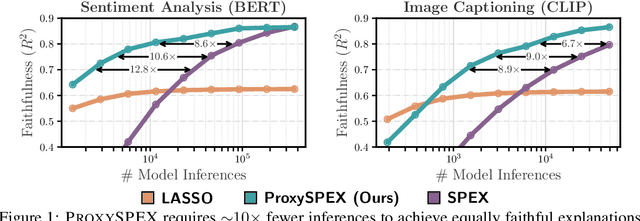


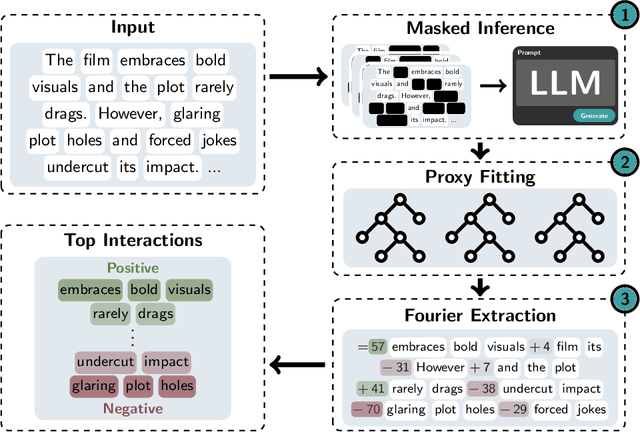
Abstract:Large Language Models (LLMs) have achieved remarkable performance by capturing complex interactions between input features. To identify these interactions, most existing approaches require enumerating all possible combinations of features up to a given order, causing them to scale poorly with the number of inputs $n$. Recently, Kang et al. (2025) proposed SPEX, an information-theoretic approach that uses interaction sparsity to scale to $n \approx 10^3$ features. SPEX greatly improves upon prior methods but requires tens of thousands of model inferences, which can be prohibitive for large models. In this paper, we observe that LLM feature interactions are often hierarchical -- higher-order interactions are accompanied by their lower-order subsets -- which enables more efficient discovery. To exploit this hierarchy, we propose ProxySPEX, an interaction attribution algorithm that first fits gradient boosted trees to masked LLM outputs and then extracts the important interactions. Experiments across four challenging high-dimensional datasets show that ProxySPEX more faithfully reconstructs LLM outputs by 20% over marginal attribution approaches while using $10\times$ fewer inferences than SPEX. By accounting for interactions, ProxySPEX identifies features that influence model output over 20% more than those selected by marginal approaches. Further, we apply ProxySPEX to two interpretability tasks. Data attribution, where we identify interactions among CIFAR-10 training samples that influence test predictions, and mechanistic interpretability, where we uncover interactions between attention heads, both within and across layers, on a question-answering task. ProxySPEX identifies interactions that enable more aggressive pruning of heads than marginal approaches.
PCS-UQ: Uncertainty Quantification via the Predictability-Computability-Stability Framework
May 13, 2025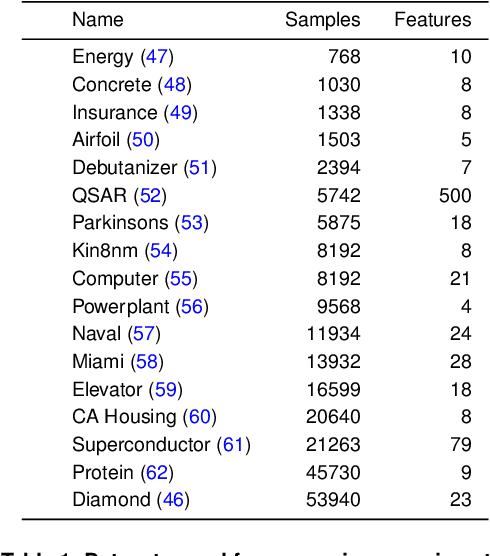
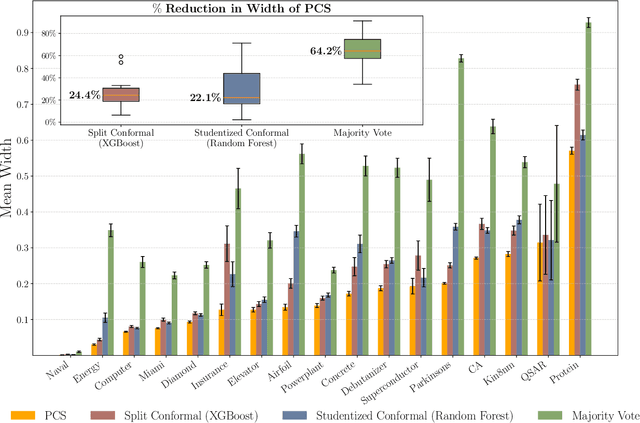
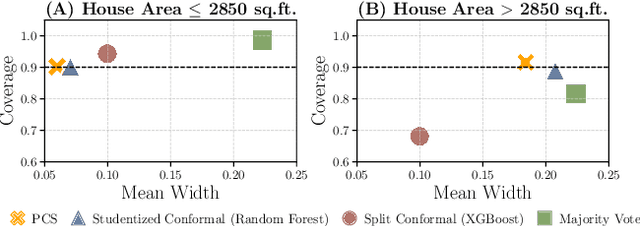
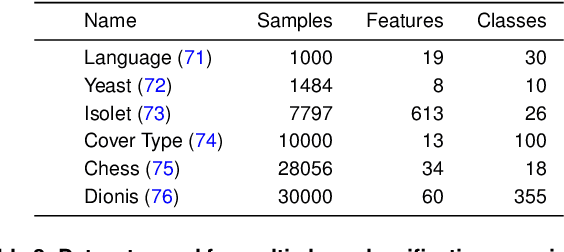
Abstract:As machine learning (ML) models are increasingly deployed in high-stakes domains, trustworthy uncertainty quantification (UQ) is critical for ensuring the safety and reliability of these models. Traditional UQ methods rely on specifying a true generative model and are not robust to misspecification. On the other hand, conformal inference allows for arbitrary ML models but does not consider model selection, which leads to large interval sizes. We tackle these drawbacks by proposing a UQ method based on the predictability, computability, and stability (PCS) framework for veridical data science proposed by Yu and Kumbier. Specifically, PCS-UQ addresses model selection by using a prediction check to screen out unsuitable models. PCS-UQ then fits these screened algorithms across multiple bootstraps to assess inter-sample variability and algorithmic instability, enabling more reliable uncertainty estimates. Further, we propose a novel calibration scheme that improves local adaptivity of our prediction sets. Experiments across $17$ regression and $6$ classification datasets show that PCS-UQ achieves the desired coverage and reduces width over conformal approaches by $\approx 20\%$. Further, our local analysis shows PCS-UQ often achieves target coverage across subgroups while conformal methods fail to do so. For large deep-learning models, we propose computationally efficient approximation schemes that avoid the expensive multiple bootstrap trainings of PCS-UQ. Across three computer vision benchmarks, PCS-UQ reduces prediction set size over conformal methods by $20\%$. Theoretically, we show a modified PCS-UQ algorithm is a form of split conformal inference and achieves the desired coverage with exchangeable data.
Long-Short Chain-of-Thought Mixture Supervised Fine-Tuning Eliciting Efficient Reasoning in Large Language Models
May 06, 2025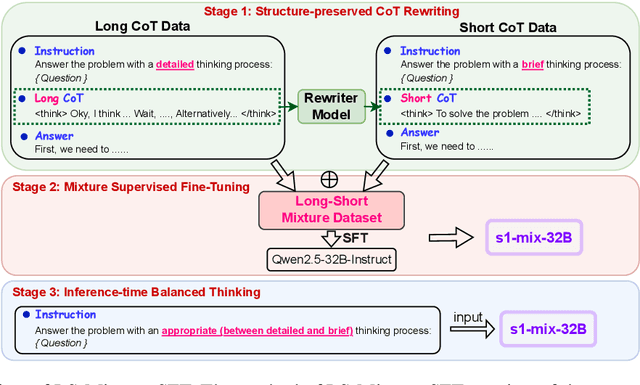
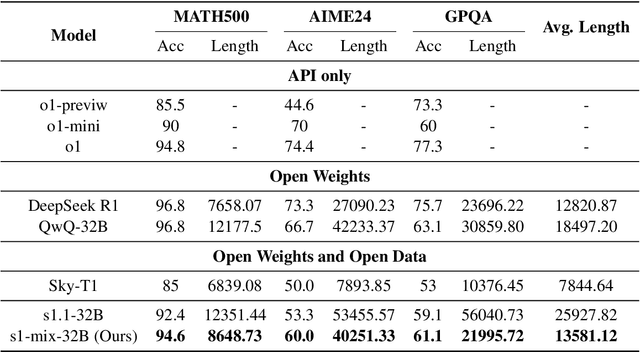
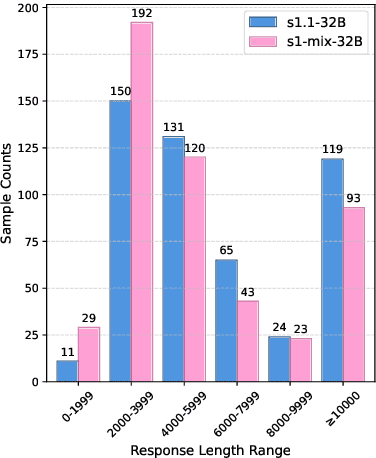

Abstract:Recent advances in large language models have demonstrated that Supervised Fine-Tuning (SFT) with Chain-of-Thought (CoT) reasoning data distilled from large reasoning models (e.g., DeepSeek R1) can effectively transfer reasoning capabilities to non-reasoning models. However, models fine-tuned with this approach inherit the "overthinking" problem from teacher models, producing verbose and redundant reasoning chains during inference. To address this challenge, we propose \textbf{L}ong-\textbf{S}hort Chain-of-Thought \textbf{Mixture} \textbf{S}upervised \textbf{F}ine-\textbf{T}uning (\textbf{LS-Mixture SFT}), which combines long CoT reasoning dataset with their short counterparts obtained through structure-preserved rewriting. Our experiments demonstrate that models trained using the LS-Mixture SFT method, compared to those trained with direct SFT, achieved an average accuracy improvement of 2.3\% across various benchmarks while substantially reducing model response length by approximately 47.61\%. This work offers an approach to endow non-reasoning models with reasoning capabilities through supervised fine-tuning while avoiding the inherent overthinking problems inherited from teacher models, thereby enabling efficient reasoning in the fine-tuned models.
Enhancing CBMs Through Binary Distillation with Applications to Test-Time Intervention
Mar 09, 2025Abstract:Concept bottleneck models~(CBM) aim to improve model interpretability by predicting human level ``concepts" in a bottleneck within a deep learning model architecture. However, how the predicted concepts are used in predicting the target still either remains black-box or is simplified to maintain interpretability at the cost of prediction performance. We propose to use Fast Interpretable Greedy Sum-Trees~(FIGS) to obtain Binary Distillation~(BD). This new method, called FIGS-BD, distills a binary-augmented concept-to-target portion of the CBM into an interpretable tree-based model, while mimicking the competitive prediction performance of the CBM teacher. FIGS-BD can be used in downstream tasks to explain and decompose CBM predictions into interpretable binary-concept-interaction attributions and guide adaptive test-time intervention. Across $4$ datasets, we demonstrate that adaptive test-time intervention identifies key concepts that significantly improve performance for realistic human-in-the-loop settings that allow for limited concept interventions.
SPEX: Scaling Feature Interaction Explanations for LLMs
Feb 19, 2025Abstract:Large language models (LLMs) have revolutionized machine learning due to their ability to capture complex interactions between input features. Popular post-hoc explanation methods like SHAP provide marginal feature attributions, while their extensions to interaction importances only scale to small input lengths ($\approx 20$). We propose Spectral Explainer (SPEX), a model-agnostic interaction attribution algorithm that efficiently scales to large input lengths ($\approx 1000)$. SPEX exploits underlying natural sparsity among interactions -- common in real-world data -- and applies a sparse Fourier transform using a channel decoding algorithm to efficiently identify important interactions. We perform experiments across three difficult long-context datasets that require LLMs to utilize interactions between inputs to complete the task. For large inputs, SPEX outperforms marginal attribution methods by up to 20% in terms of faithfully reconstructing LLM outputs. Further, SPEX successfully identifies key features and interactions that strongly influence model output. For one of our datasets, HotpotQA, SPEX provides interactions that align with human annotations. Finally, we use our model-agnostic approach to generate explanations to demonstrate abstract reasoning in closed-source LLMs (GPT-4o mini) and compositional reasoning in vision-language models.
 Add to Chrome
Add to Chrome Add to Firefox
Add to Firefox Add to Edge
Add to Edge